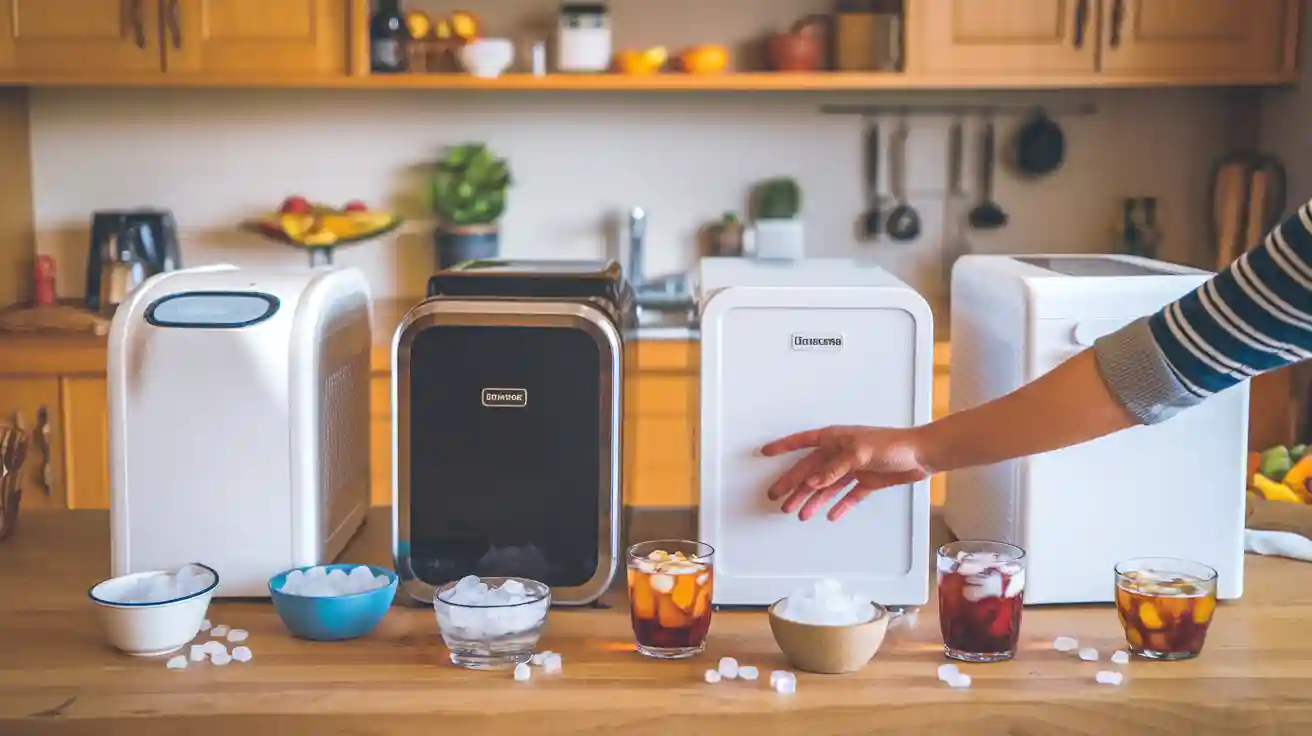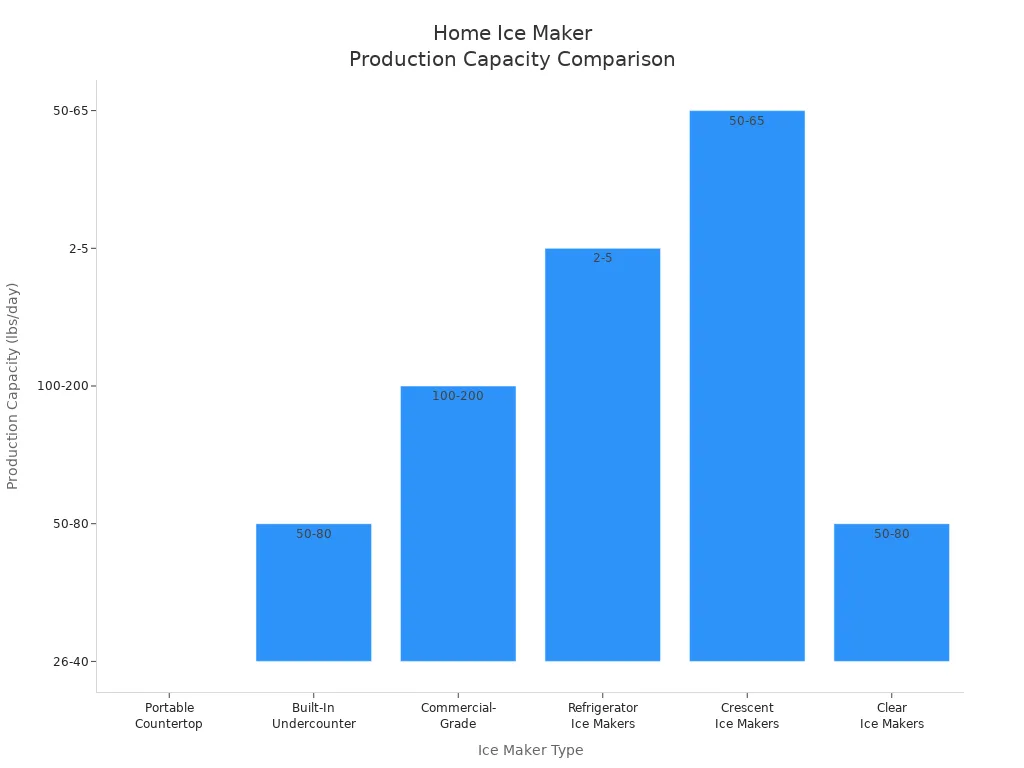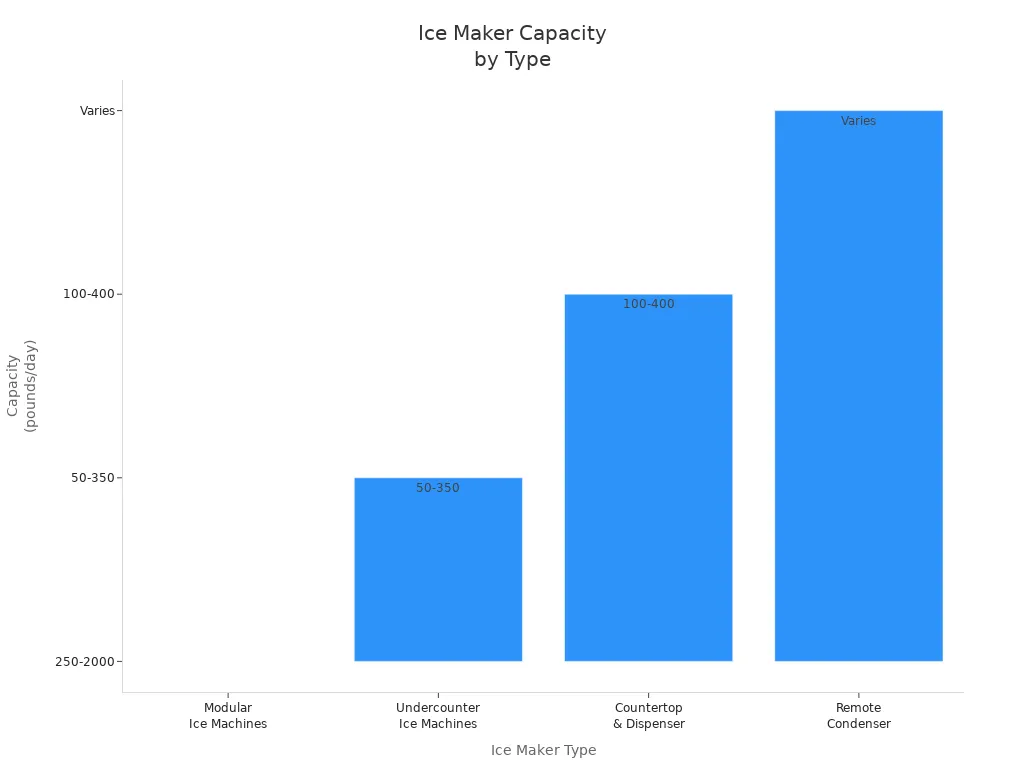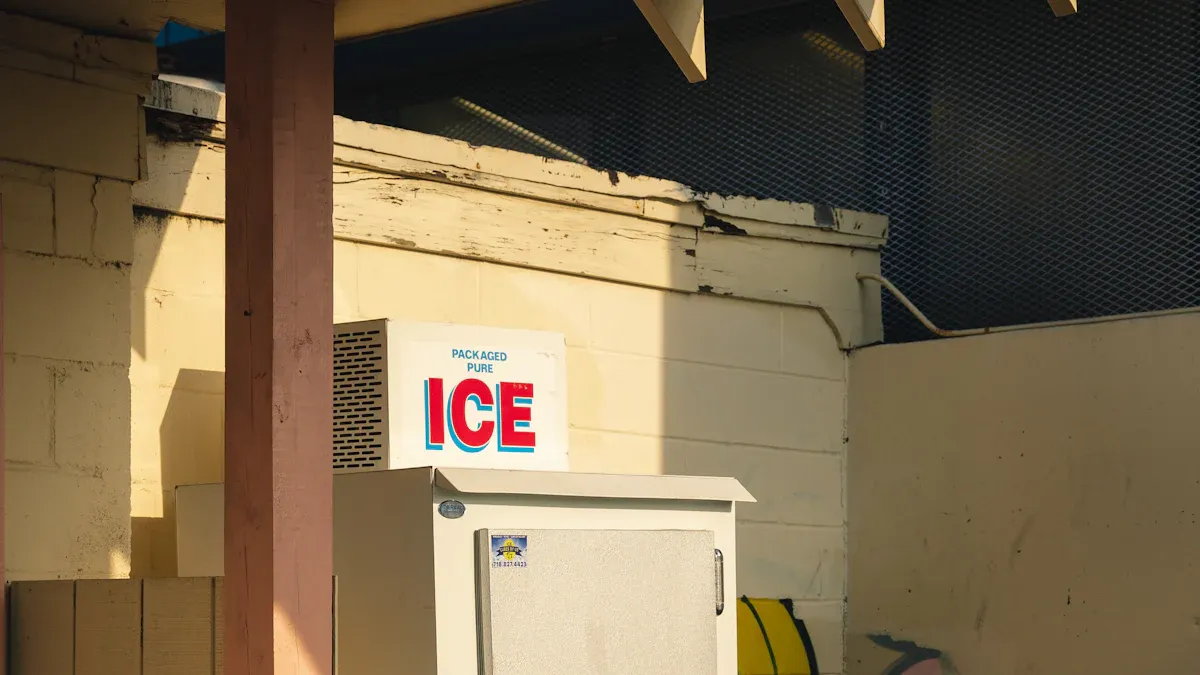
You want cold drinks ready for every party or family night. With an ice maker in your kitchen, you never scramble for ice or wait for freezer trays. Many ice makers for home keep fresh ice flowing, so you can serve guests quickly.
- You get quiet operation and easy cleaning.
- Smart features let you control your ice maker from your phone.
Ice Makers for Home: Identify Your Ice Needs
Quantity and Frequency
When you start looking at ice makers for home, you need to think about how much ice you use and how often you need it. If you have a big family or love hosting parties, you probably go through a lot of ice. Some ice makers for home can make up to 50 pounds of ice every day. That’s perfect for large gatherings or busy households. If you only need ice for a few drinks each day, a smaller ice maker or even the one built into your fridge might be enough.
Your lifestyle plays a huge role in your choice. If you entertain guests often, you want an ice maker that keeps up with demand. Freestanding ice makers for home work well for these situations because they produce more ice and store it longer. You don’t want to run out of ice in the middle of a barbecue or birthday party. On the other hand, if you just need ice for your morning iced coffee, you can pick a compact countertop model.
Tip: Always check the daily ice output and storage capacity before you buy. This helps you avoid disappointment when you need ice the most.
Preferred Type of Ice (Nugget, Bullet, Cube, Clear)
Ice makers for home come in many types, and each one produces a different kind of ice. You might not realize how much the shape and texture of ice can change your drink. Some people love nugget ice because it’s soft and chewable. Others prefer cubed ice for its classic look and slow melting. If you want ice that keeps your drink cold without watering it down, clear ice technology is a game-changer.
Here’s a quick look at the main types of ice you can get from ice makers for home:
| Ice Type | Texture & Characteristics | Advantages | Best Use Cases |
|---|---|---|---|
| Nugget | Soft, chewable, porous | Kid-friendly, great for smoothies | Everyday drinks, healthcare, parties |
| Bullet | Small, hollow cylinders | Fast production, slow melting | Cocktails, smoothies, family use |
| Cubed | Square or rectangular, solid | Economical, easy to use | Parties, daily drinks |
| Clear | Dense, bubble-free, premium | Slow melting, preserves flavor | Premium spirits, special occasions |
You might want nugget ice for blended drinks or soft drinks. Nugget ice absorbs flavors and feels good to chew. Bullet ice works well for smoothies and cocktails because it melts slowly and blends easily. Cubed ice is the classic choice for most drinks and parties. It’s easy to make and fits almost any glass. Clear ice, made with clear ice technology, looks fancy and melts slowly, so your drink stays cold and tasty longer.
- Nugget ice is soft and absorbs flavors, making it popular for blended drinks and soft drinks.
- Cubed ice melts slowly, so it keeps cocktails and sodas cold without watering them down.
- Bullet ice is versatile and works for many types of drinks.
- Clear ice is perfect for premium spirits because it keeps drinks cold and preserves taste.
When you pick an ice maker for home, think about what kind of ice you like best. The right ice can make your drinks taste better and look more appealing. If you want to impress your guests or just enjoy a perfect glass of lemonade, choose an ice maker that matches your favorite ice type.
Ice Maker Buying Guide: Compare Main Types of Ice Makers
When you start shopping for an ice maker, you’ll see many options. Each type fits a different kitchen and lifestyle. This ice maker buying guide will help you compare the main types of ice makers so you can pick the best one for your home.
Countertop Ice Makers
Countertop ice makers are perfect if you want something simple and portable. You just plug in the machine, fill it with water, and wait for fresh ice. Most countertop ice makers fit easily on your kitchen counter. You can move them around or even take them to a party. These machines usually make bullet or small cube ice. You get ice fast—sometimes in just six minutes.
Here’s a quick look at what you get with a countertop ice maker:
| Ice Maker Type | Typical Production Capacity (lbs/day) | Typical Ice Storage Capacity (lbs) | Typical Dimensions (inches) |
|---|---|---|---|
| Portable Ice Makers | Just under 30 | Slightly over 2 | 17 x 14 x 16 |
A portable ice maker works well for small kitchens, dorm rooms, or RVs. You don’t need a water line or special installation. You just need an outlet. Most portable ice makers have auto shut-off and self-cleaning features. You can choose different ice sizes, which is great for drinks or snacks.
Tip: If you want ice quickly and don’t have much space, countertop ice makers are a smart choice.
Undercounter Ice Makers
Undercounter ice makers are built to fit under your kitchen counter. These machines make more ice than countertop models. You get nugget, crescent, or clear ice, depending on the model. Undercounter ice makers need a water line, drainage, and good ventilation. You may need a professional to install one.
Here’s what you should know about undercounter ice makers:
| Ice Maker Type | Installation Requirements | Ice Types Produced | Production Capacity (lbs/day) | Features & Notes |
|---|---|---|---|---|
| Built-In Undercounter | Requires dedicated water line, drainage, ventilation; professional install | Nugget, crescent, clear, adjustable thickness | 50-80 | Stainless steel, auto-cleaning, larger storage (up to 24 lbs), customizable ice thickness |
Undercounter ice makers work well for busy families or people who entertain often. You get a steady supply of ice without refilling water. These machines last longer and look sleek in your kitchen. You need to measure your cabinet space and plan for ventilation. Make sure you have a water line and drainage set up before you buy.
Here’s a simple checklist for installing an undercounter ice maker:
- Pick a spot with a water line and outlet.
- Measure your cabinet space.
- Leave room for ventilation.
- Plan for drainage.
- Connect water supply and drain line.
- Plug into a grounded outlet.
- Install accessories.
- Clean the bin and water lines often.
Countertop models don’t need all this setup, but undercounter ice makers give you more ice and better features.
Freestanding Ice Makers
Freestanding ice makers are bigger and make lots of ice fast. You can put them in your garage, basement, or even a home bar. These machines are not portable. You may need help to install them because they often need drainage and a strong floor. Freestanding ice makers are great for parties or big families.
Let’s compare freestanding ice makers and built-in models:
| Feature | Freestanding Ice Makers | Built-in (Undercounter) Ice Makers |
|---|---|---|
| Portability | Less portable; large, fully finished units; require professional installation and drainage | Less portable; permanently installed; integrated into cabinetry; require ventilation |
| Output | High ice output quickly; suitable for garages or commercial use | Typically lower output compared to freestanding units |
| Design | Utilitarian, standalone units ready to plug in | Designed to blend seamlessly with kitchen cabinetry; panel-ready options available |
| Installation | May require professional installation due to drainage needs | Permanently installed, less movable |
Freestanding ice makers give you more ice than most built-in models. You can use them for big events or in places where you need lots of ice. They don’t blend into your kitchen like built-in ice makers, but they get the job done.

Built-In Ice Makers
Built-in ice makers fit right into your kitchen cabinets. You get a clean look and steady ice supply. These machines make clear, nugget, or crescent ice. Built-in ice makers need a water line and drainage. You can choose panel-ready models to match your cabinets.
Here are some pros and cons of built-in ice makers:
-
Advantages:
- High ice production for big families or parties.
- Continuous ice supply—no refilling needed.
- Custom look with panel-ready options.
- Durable and long-lasting.
- Can boost your home’s value.
-
Disadvantages:
- Professional installation and plumbing needed.
- Fewer places to install because of plumbing.
- More expensive than portable ice makers.
- Smaller ice bin and slower recovery than freestanding ice makers.
A built-in ice maker is perfect if you want your kitchen to look neat and modern. You get premium ice and don’t have to worry about running out. If you want easy installation and portability, you might prefer a portable or countertop ice maker.
Note: Built-in ice makers cost more and need planning, but they give your kitchen a high-end feel.
When you compare different types of ice makers, think about your space, ice needs, and budget. Countertop ice makers are easy and portable. Undercounter ice makers give you more ice and fit under your counter. Freestanding ice makers make lots of ice for big events. Built-in ice makers blend into your kitchen and offer premium features. Each type has its own benefits, so pick the one that matches your lifestyle.
Buying an Ice Maker: Evaluate Key Features
Size and Capacity
When buying an ice maker, you want to match the machine’s size and capacity to your kitchen and lifestyle. If you have a small kitchen, a compact model fits best. Larger ice makers work well for big families or frequent parties. Check the daily ice production and storage bin size before you decide. Here’s a quick look at how capacity matches different spaces:
| Ice Maker Type | Size/Capacity Range | Suitable Kitchen Space | Key Considerations |
|---|---|---|---|
| Countertop | 100-400 lbs/day | Small kitchens, offices | Compact, easy to move |
| Undercounter | 50-350 lbs/day | Home bars, backup units | Fits under counters, space-saving |
| Modular | 250-2,000+ lbs/day | Large kitchens, events | Needs more space, pro installation |

Ice Shape and Texture
You have lots of options for ice shapes. Large cubes melt slowly and keep drinks cold longer. Nugget ice is soft and chewable, perfect for sodas. Crushed ice chills drinks fast but melts quickly. Clear ice looks fancy and melts slower than cloudy ice. Think about what to look for in your favorite drinks—shape and texture change the taste and style.
- Large cubes: Great for whiskey and cocktails.
- Nugget ice: Chewable, fun for kids and parties.
- Crushed ice: Best for iced coffee and summer drinks.
- Clear ice: Premium look, slow melting.
Speed of Ice Production
Nobody likes waiting for ice. Some ice makers produce ice in minutes, while others take longer. Portable models often make ice faster than built-in fridge makers. If you host parties, pick a machine with quick ice production.
Installation Requirements
The installation of the ice maker depends on the type. Countertop models need only an outlet. Built-in and undercounter ice makers require a water line and sometimes professional help. Always check the instructions before you start.
Drainage Options
You’ll find different drainage options. Portable ice makers don’t need a drain, so you can place them anywhere. Built-in models may use gravity drains or pumps. Gravity drains work if you have a nearby floor drain. Pumps help when you need flexible placement but add cost.
| Drainage Option | Description | Pros | Cons |
|---|---|---|---|
| No Drain Required | Manual water refilling | Flexible placement | Limited ice production |
| Gravity Drain | Uses slope to drain water | Simple, cost-effective | Needs proper installation |
| Drain Pump | Pumps water to plumbing | Flexible placement | Adds complexity and cost |
Energy Efficiency
Energy-efficient ice makers save money over time. ENERGY STAR models use about 20% less energy, which can save you up to $125 a year. Look for machines with advanced insulation and programmable settings to lower your bills.
Noise Level
Most ice makers run quietly. Popular countertop models produce 30–50 decibels, similar to a whisper or fridge hum. Some premium models reach up to 60 decibels. If you want a peaceful kitchen, check the noise rating before buying an ice maker.
Maintenance Needs
Regular cleaning keeps your ice maker working well. Wipe surfaces daily, clean the bin weekly, and descale monthly. Check water lines and filters often. A good maintenance schedule helps your ice maker last longer and keeps your ice fresh.
Ice Makers: Consider Kitchen Space and Placement

Measuring Available Space
Before you pick an ice maker, you need to measure your kitchen carefully. Start by choosing a location with a water line and a grounded outlet. This makes installation easier. Use a tape measure to check the height, width, and depth of your chosen spot. You want the ice maker to fit without blocking cabinets or appliances. Remember to leave space for the door to swing open and for ventilation. If you plan to install an undercounter model, measure the cabinet opening and make sure there’s enough clearance. Here’s a simple checklist to help you:
- Pick a location with water and power access.
- Measure height, width, and depth.
- Check door swing and ventilation space.
- Leave room for airflow around the unit.
Placement for Convenience
The right location can make your kitchen work better. You have many options for placing your ice maker. If you put it in a kitchen island, you create a central spot where everyone can grab ice. This helps during parties or busy family meals. Placing the ice maker near the refrigerator and sink keeps your workflow smooth. You avoid crowding the cooking area. Some people choose a butler’s pantry for their ice maker. This keeps noise and clutter out of the main kitchen. Undercounter options save space and fit neatly under counters. You can also place your ice maker near a bar or dining room for easy drink service. Outdoor or utility spaces work well for pool parties or bulk ice needs.
- Kitchen island: Central access for multiple users.
- Near fridge and sink: Smooth workflow.
- Butler’s pantry: Less noise and clutter.
- Undercounter: Saves space, fits under counters.
- Bar or dining room: Dedicated beverage station.
- Outdoor/utility: Great for special events.
Ventilation and Access
Good ventilation keeps your ice maker working well. You need at least one foot of clearance on all sides and above the machine. This lets heat escape and prevents hot air from coming back in. If vents get blocked, your ice maker may overheat and make less ice. Keep the internal temperature near 70°F for best results. Make sure technicians can reach the top, sides, and inside for cleaning and repairs. Choose a location away from direct sunlight, high temperatures, and humidity. A flat, sturdy surface supports the machine. Clean surroundings help with maintenance and hygiene. If you install an undercounter model, follow the manufacturer’s airflow requirements. More clearance makes service easier and helps your ice maker last longer.
Tip: Professional installation helps align plumbing, electrical, and ventilation needs for all options.
Ice Maker: Set Your Budget and Compare Models
Price Ranges
You can find ice makers at many price points. Small countertop models start around $130 and go up to $600 for premium features. Mid-range machines cost about $300. Built-in or undercounter ice makers often cost $800 or more. Your budget helps you decide which features matter most. If you want simple ice for daily drinks, a budget model works well. If you want smart features or nugget ice, you may need to spend more.
Value for Money
Not all ice makers are the same. Some give you more for your money. Take a look at this table to see how popular models stack up based on user reviews:
| Model | Price Range | Ice Type | Key Features | Value for Money |
|---|---|---|---|---|
| GE Profile Opal 2.0 | $567-$599 | Nugget | WiFi, auto-clean, quiet, premium | High for quality seekers |
| Frigidaire Gallery EFIC255 | ~$300 | Bullet | Quiet, good capacity | Good balance |
| Magic Chef MCIM22B | $129-$189 | Bullet | Fast, easy to use | Best for budget |
| Silonn, Igloo, AGLUCKY | $100-$150 | Bullet | Basic, noisier, less ice | Lower |
| Luma Comfort | ~$250 | Clear | Slow-melting, slower production | Niche, lasts longer |
You might wonder if ice makers worth it for your kitchen. If you want fast ice and easy cleaning, the best ice maker for you could be a mid-range or premium model. Some budget models work well for small families. If you love nugget ice or want smart controls, you may find higher-priced ice makers worth it.
Warranty and Support
A good warranty protects your investment. Many brands offer multi-year coverage on parts and labor. For example, Manitowoc Ice gives you 2 to 3 years on most parts and labor, and up to 5 years on compressors. Some home warranty services, like Liberty Home Guard, cover repairs for common issues such as compressor or water line problems. You file a claim, pay a set fee, and a local contractor handles repairs or replacements. Here are some common warranty options:
- 2–3 years parts and labor coverage
- 5 years compressor warranty
- 90-day warranty on replacement parts
- Labor warranty covers repairs but not travel or maintenance
Always check the warranty details before you buy. Good support makes ice makers worth it, especially if you want peace of mind.
Ice Makers for Home: Look for User-Friendly Features
Easy Controls and Settings
You want an ice maker that anyone in your family can use. Many modern models have one-click operation, so you just press a button and get fresh ice. Simple controls make life easier, especially if you don’t want to read a thick manual. Some machines have indicator lights that tell you when the ice basket is full or when you need to add water. These features help you avoid guesswork and keep your ice maker running smoothly.
Tip: Look for models with clear buttons and easy-to-read displays. This way, you never have to wonder what to do next.
Cleaning and Maintenance Tips
Keeping your ice maker clean means you always get fresh, tasty ice. Many new machines come with self-cleaning functions. You just press a button, and the machine cleans itself. This saves you time and keeps your ice safe to eat. If your model doesn’t have this feature, wipe the inside with a soft cloth and run a cleaning cycle with vinegar every month. Always empty the ice basket and let the machine dry when not in use.
- Clean the water reservoir often.
- Use filtered water for better-tasting ice.
- Check for mold or scale buildup.
Smart Features (Wi-Fi Connectivity, Timers, Self-Cleaning, Ice Basket, Scoop)
Smart features make your ice maker even more convenient. Some models connect to Wi-Fi, so you can control them with your phone. You can schedule ice production or get alerts when it’s time to clean. Timers let you set when the machine starts or stops. Many portable ice maker models have quiet operation, which is great for kitchens and offices. Energy-efficient designs help you save on power bills. You also get handy extras like a scoop or removable ice basket for easy serving.
If you want a machine that fits your busy life, choose one with smart connectivity and self-cleaning. These features make owning an ice maker simple and stress-free.
You want the perfect ice maker for your kitchen, so start by thinking about your ice needs and available space. Compare different models, read reviews, and look for long-term value. If you take your time, you’ll find an ice maker that fits your lifestyle and keeps drinks cold every day.
FAQ
How often should you clean your ice maker?
You should clean your ice maker every month. This keeps your ice fresh and your machine running well. Always follow the cleaning steps in your user manual.
Can you use tap water in your ice maker?
You can use tap water, but filtered water makes better-tasting ice. Filtered water also helps prevent mineral buildup inside your machine.
What do you do if your ice maker stops making ice?
First, check the water supply and power. Make sure the ice bin is not full. If it still does not work, try unplugging and restarting the machine.


